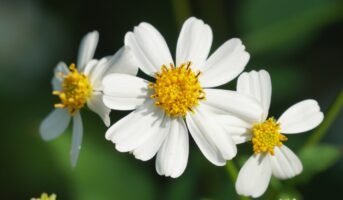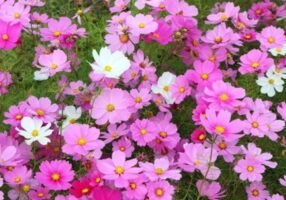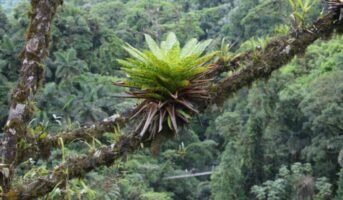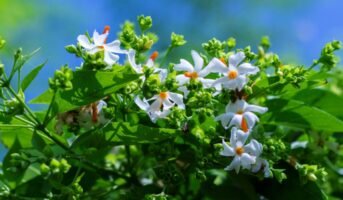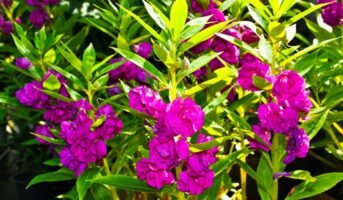What is salvia splendens?
Salvia splendens is a native American plant. This outdoor plant is also known by its common names such as scarlet sage and red salvia. Additionally, this herbaceous is perennial and is commonly found in Brazil.
Salvia splendens characteristics
Salvia splendens can grow to a height of 1.3 m (4.3 ft), especially in the wild. Soil mixed with perlite provides the best medium for Pothos to flourish.
Salvia splendens plant bears red flowers that form the main attraction of the Salvia splendens plant. These flaming red flowers look like small elongated bells and grow in clusters. Salvia splendens are popularly placed in malls, gardens, and parks for their beauty.

Source: Pinterest
Salvia splendens is known to be low maintenance among other flowering plants. Salvia splendens do not have much requirement for fertilisers and can thrive in cool climates without any help. Salvia splendens plants usually grow in the wild in America and are rarely farmed. Sister plants of Salvia splendens bear white and purple coloured flowers and look equally beautiful.
You can plant Salvia splendens in your garden and enjoy the beauty of these red flowers from your window. However, if you are a pet parent, you need to keep your fur babies away from the Salvia splendens plants. Salvia splendens is toxic to animals, especially to dogs, so you can avoid this plant if you have pets at home.
Salvia Splendens: Key facts
| Name | Salvia splendens |
| Type | Shrub |
| Native | America |
| Season | Winter and Spring |
| Temperature | 22° C – 24° C |
| Soil Requirements | Neutral and well-drained |
| Water | Daily in regulated quantities |
| Light | Direct sunlight |
| Fertiliser | Granular fertiliser high in phosphorus |
| Flower | Red bunches |
| Height | 1.5 feet |
| Bugs | Spider mites |
| Pet friendly | No |
Salvia splendens: Ideal conditions to grow and maintain

Source: Pinterest
Salvia splendens is not that difficult to grow. The plants mature fast and flower well when in season. In tropical countries, they bloom mostly in winter and yield plenty of flowers. In colder climates, they can bloom almost throughout the year. The plants, however, cannot survive frost and cease to flower in extremely cold temperatures.
If you are someone who wants to plant Salvia splendens at home, here are a few things you must keep in mind.
Also have a look at these easy growing plants
Soil
Salvia splendens requires fertile and well-drained soil for growth. The plant draws nourishment from the soil, so it’s better to fertilise it at least once every month. You can cease to fertilise it in extreme winters when the flowers have already shed. The plant prefers moist soil, so make sure to water every day in regulated quantities.
Sunlight
Salvia splendens is an outdoor plant. This means it requires plenty of sunlight, especially in winter. It needs to be planted in semi-shade or open spaces so that it can access bright sunlight. The minimum requirement of salvia plants is about three to four hours of sunlight every day.
Water
Salvia splendens loves water and moist soil. You can water it daily, especially in the summers when it requires water the most. However, keep in mind that overwatering these plants can lead to root rot that might kill the plant completely. Therefore, avoid watering if the soil looks too moist.
How to keep salvia blooming all summer?
While no care will still result in perennial salvias blooming twice in a season, if you maintain it properly and prune the old and spent flowers, you can also ensure that salvias bloom three of four times, thus keeping salvia blooming all summer. What is important is that to ensure consecutive blooms, one has to prune the plant properly after the first bloom of salvia. You can cut the stems till the base so that the next lot for blooming gets ready.
Salvia splendens: Common pests and diseases associated
Salvia splendens is prone to catching diseases just like any other plant. It also gets frequently infected by pests like slugs, snails, and whiteflies. Always check your Salvia splendens plants before you buy them. Make sure your salvia splendens sapling doesn’t have these pests when you bring them home. Drenching the Salvia splendens plant in water and neem oil will solve the problem. Additionally, a mix of dishwater liquid and water is also effective in removing pests from plants.
Salvia splendens: Benefits
Ornamental
Salvia splendens is a great plant that is used for decorative purposes. The flaming red hue of the flowers is a great addition to a garden and is extremely beautiful to look at. The Salvia splendens plant can be an important collection for hobbyists and gardens who want to have a colourful variety of flowers.
Medicinal
Additionally, Salvia splendens has amazing health benefits. Indians have used extracts from this plant in ayurvedic and herbal medicines. These medicines were used for treating wounds and curing medical problems in people. The Salvia splendens plant is still widely used as medicine for certain illnesses and yields great curative results.

Source: Pinterest
Here are some of the top health benefits of Salvia splendens that are known so far:-
- Since ancient times, Indian traditional medicine has made use of salvia plants to treat diabetes mellitus in patients.
- The Salvia splendens plant is useful for removing mucus congestion, which helps treat colds and coughs.
- Seeds of the Salvia splendens plant are commonly used as an emetic, for dysentery, colic, and haemorrhoids.
- Extracts of salvia plants have anti-inflammatory properties which can help alleviate swelling and bloating of the body. Additionally, Salvia splendens plant helps deal with infection and relieves pain.
FAQs
Do Salvias prefer sun or shade?
Salvias or Salvia splendens prefer sunlight or even indirect bright light. Do not keep them in complete shade except in summer.
How do you prune red Salvia?
You need to prune your salvia plants once the flowers have faded. This phenomenon usually occurs in early summer. You can cut the stems down to the base to promote fresh and healthy growth for the next blooming season.
How many years do salvias live?
Salvias can grow for a few decades if kept in good weather conditions and with proper care. In California, they have grown for over 30 years.
Housing News Desk is the news desk of leading online real estate portal, Housing.com. Housing News Desk focuses on a variety of topics such as real estate laws, taxes, current news, property trends, home loans, rentals, décor, green homes, home improvement, etc. The main objective of the news desk, is to cover the real estate sector from the perspective of providing information that is useful to the end-user.
Facebook: https://www.facebook.com/housing.com/
Twitter: https://twitter.com/Housing
Email: [email protected]

